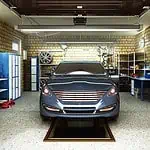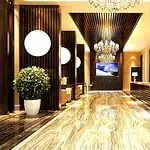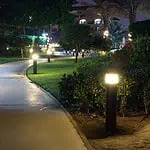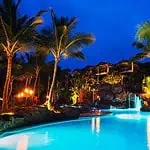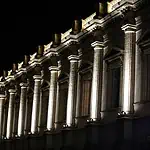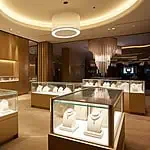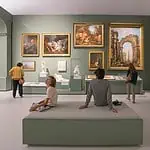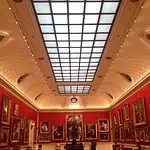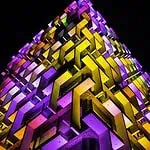Do you know light can greatly impact the health condition of patients? This is why you should be wise when choosing hospital light fixtures. In this case, LED lights are your one way solution. But why choose LED for hospital lighting?
As the hospital’s lights keep on 24/7, the electricity bill is a major concern. And to minimize this cost, nothing can beat the energy efficiency of LED lights. However, the lighting requirements of different zones of the hospital vary. For instance, the doctor’s chamber needs bright task lighting. In contrast, warm lighting is preferable for the patient wards. Besides, there are other hospital lighting like UV-C disinfection lights, circadian rhythm lights, etc. And these advanced features are not available with traditional lights. Here the game of LED lights begins!
In this article, I will provide a comprehensive guide to hospital lighting and state why LED is the best choice for hospitals. So, without any further delay, let’s jump into the discussion-
What Is Hospital Lighting?
Hospital lighting includes lighting facilities for the healthcare sector, like clinics, hospitals, and other medical platforms. It intends to give comfortable lighting for the patients, doctors, and other employees to provide medical services with ease. The light fixtures used for hospital lights have different requirements than other commercial lighting. For instance, mobile light fixtures are used in operation theaters to ensure portability. However, for general lighting, recessed lights, LED strips, and LED panel lights are ideal options for hospitals.
The brightness, color temperature, and designs of the hospital light fixture vary from one section to the other. For example- the reception and lobby of the hospital is the most attractive zone. Here you can install designer fixtures to give your hospital an aesthetic look. But you need to keep the lighting plain and simple for the doctor’s chamber and patient ward. LED strips, recessed lights, or flat panel lights suit these places. So, continue reading to know all details about hospital lighting.
Types of LED Lights for Hospitals
Different types of lighting are used for hospital lighting. The most common types are as follows-
LED Panel Lights for Grid Ceilings
LED panel lights are thin, flat fixtures suitable for grid ceilings of hospitals. These light fixtures give a formal, clean ambiance that fits the hospital environment. You can mount these lights to the stairways, corridor, waiting room, wardroom, doctors cabinet, and washrooms. Uniform and even lighting of LED panel lights minimize glaring and eye strain. Thus, it provides a comfortable environment for patients, doctors, and other employees.
Commercial Recessed LED Downlights
Commercial recessed lights are an excellent option to give your hospital a modern and elegant look. The built-in structure of these fixtures creates a professional and reliable hospital atmosphere. You will find this fixture in the patient’s room, corridor, waiting room, or at the reception of big and luxurious hospitals. However, in installing these fixtures, the type of ceiling is a crucial consideration. You will require an IC-rated recessed fixture if your hospital ceiling is insulated. If you go for non-IC-rated ones, it can cause fire breakout hazards. So, keeping the safety of your hospital in mind, do proper research on this fact. This article will help you with all information on IC and non-IC recessed lights- IC Vs. Non-IC Rated Recessed Light Fixtures.
Surface LED Dome Lights
Surface LED dome lights are suitable for hospital ceilings with limited space. You can see them in the areas where more diffused lighting is required, like- the nurse station, hallway, or waiting room. They are easy to install and maintain. Above all, LED dome lights have simple yet aesthetic designs that complement the hospital’s interior.
LED Strip Lights
Hospitals require indirect lighting to reduce glare. And for this, LED strip lights are an outstanding option for hospitals. You will find them in most hospitals with modern interior decorations. Cove lighting in the ceiling of doctors’ offices, wardrooms, reception, pharmacy, and examination rooms are common areas where you can find these fixtures. Besides, you can install them under the cabinets to give a soft yet elegant vibe.
Mobile LED Light Fixtures
Mobile LED light fixtures are portable lights that aid flexible health checkups and treatments. These light fixtures come with an adjustable arm or gooseneck that doctors can position according to their needs. Seven and four reflector theater lights are mostly mobile fixtures in operation theaters. You will find these fixtures in-
- Gynecology
- Orthopedics
- Urology
- Labor
- Additional lamp in the OT
UV-C LED Disinfection Lighting
Hospitals use UV-C LED disinfection lights in closed spaces like OT or patient rooms to keep them germ-free. These lights have germicidal properties and can kill bacteria, viruses, and other pathogens. So, to keep the hospital environment safe and disinfected, these lights play a crucial role. But as they are very expensive, you will find them only in luxurious hospitals.
Emergency Lighting in Hospitals
What if the doctor is in the middle of an operation, and the power cuts out? The generator also needs some time to turn on. In this situation, emergency lighting is the savior. They illuminate as soon as the power cuts out. Thus, continuous lighting is ensured throughout the day. These light fixtures are mandatory for operation theater, hallways, stairs, etc. For more information, you can check Why Is Emergency Lighting Essential?
Benefits Of LED Lighting In Hospital
LED technology has brought us many advanced technologies. This makes it an excellent replacement for traditional lighting forms. So, here is the reason why you should choose LEDs for hospital lighting-
Support for Circadian Rhythm
Light color has a great impact on the human mind and health. In this case, LED lights offer color temperature-adjusting facilities. The controlling features of LED lights help the staff to keep the patient’s health care in check. It is proved that the change in light intensity and color shows increases or decreases in hormones like melatonin. Tunable LED lights are an excellent option here. You can install these lights in patient wards to adjust light settings with the body’s circadian clock. For example- switching warm lighting at least two hours before bedtime will help patients sleep properly. But all these facilities are not available with traditional; lighting like- incandescent or fluorescent bulbs. For more information, you can check Tunable White LED Strip: The Complete Guide.
Provide Better Patient Care
For hospitals, light not just provides visibility but something beyond that. The UV-C LED disinfection lights kill the germs present in the hospital rooms. These lights are used for sensitive areas where sterilization routines are strictly followed. For example, using these lights in the operation theater keeps the place hygienic and germ-free. Besides, the dimming and adjustable features also help to ensure patients feel comfortable during treatment. Thus, LED plays its role in taking proper care of the patient.
Keep Track of Medical Equipment
LED lights are compatible with light sensor technology that can track objects through tag marks. You can place the tags on the medical equipment of your hospital. The sensor in the lights can identify these tags and send you the exact location of the equipment. The technologies that facilitate this function includes-
Integrating these into LED light sensors lets you quickly find your medical devices without wasting hours searching for them.
Energy Efficiency
LED lights are highly efficient compared to other traditional lighting. Where incandescent lights consume 60 watts of energy, LEDs can light the same output using just 6 watts. This makes them an excellent lighting option for commercial areas like hospitals. As hospitals need lighting 24/7, LED lights can effectively reduce electricity bills. For more information, you can check Advantages and Disadvantages of LED Lighting.
Improve Medical Staff Efficiency
LED lights provide uniform lighting without causing direct glare. This ensures that medical staff doesn’t face any irritation while working. Thus they can check the patient’s condition, read medical charts, and treat them in a suitable atmosphere. Medical staff can also adjust light intensity or brightness to their desired level. For example, while delicate examination, dimming the lights can help improve visual contrast and reduce eye strain. In this way, the adjustability and customization of LED lights enhance the working efficiency of the medical staff.
Cost Savings
LED fixtures don’t require frequent replacement or repair like other traditional fixtures. However, they are expensive but profitable choices in the long run. Light bulbs like incandescent burn out quickly and need rapid replacement. This increases the overall cost. But with LED, you will not face these issues. The initial price will eventually offset the total cost.
Long Lifespan
Incandescent lights can last for just 1000 hours. Though fluorescent lights are a better option than incandescent, they have a lifespan of around 10000 hours. In contrast, LED lights can glow for up to 50,000 hours. And if maintained properly, they can last up to 100,000 hours! So, if you want a long-term lighting option without the hassle of frequent replacement, LEDs are the best option. Below I am adding a comparison table for different types of lighting. This will help you to know how long a LED can run!
| Lamp type | Lumens/Watt | Avg. Lumens/Watt | CRI | Lifespan (Hrs) |
| Incandescent | 8-18 | 14 | 100 | 1000 |
| T12 Fluorescent | 40-70 | 55 | 92 | 8000 |
| T8 Fluorescent | 60-80 | 70 | 85 | 6000 |
| T5 Fluorescent | 100-105 | 102.5 | 85 | 9000 |
| Mercury | 44-57 | 50 | 50 | 24000 |
| LED | 75-200 | 137.5 | 98 | 50000+ |
Low Heat Emission
LED technology does not get overheated like other lighting forms. They have a well-built heat-sinking mechanism that keeps the bulb cool. (Check this to know about heat sink- LED Heat Sink: What Is It and Why It’s Important?) when light fixtures get overheated, it causes chances of fire explosion. But LED lights minimize this risk. This makes them an ideal choice for hospitals, especially for areas with heat-sensitive equipment or pharmaceuticals.
Environment-Friendly
Unlike traditional lighting, LED lights do not contain or emit any harmful gas. They also have lower carbon footprints. As they are durable and can last for longer, it reduces manufacturing loads. This plays a role in minimizing the impact of global warming. Thus, it helps in conserving the environment.
Hospital Lighting Zones
I have divided the hospital into several zones for the best lighting effect. Consider this area and light them up, keeping specific requirements in mind-
- General Ambient Lighting
General ambient lighting refers to the overall lighting of the hospital. It includes the lobby, corridors, and other open spaces of the hospital. Usually, LED panels or dome lights are suitable for general lighting. But you can also go for recessed lights or LED strips.
- Reception Lighting
Reception is the area where visitors first approach to get appointments. Almost all hospitals have beautifully decorated reception areas. And to complement the interior, LED strips are excellent options. You can also add simple pendants or hanging light fixtures in the reception. Besides, the background of the reception is an excellent spot to place the logo or name of the hospital. You can use LED neon flex to pop up the hospital name, which can be a great marketing strategy. But be careful with the brightness of the neon lights. Remember, it is a hospital, not a bar or restaurant.
- Doctor’s Chamber Lighting
Be very careful when lighting the chamber of the doctor’s room. It is the place where doctors examine the patient and suggest treatments. So, task lighting with proper visibility is mandatory. You can install LED downlights in the examination section. However, regular panel lighting or LED strips are ok for ambient room lighting.
- Operation Theatre Lighting
The operations or surgeries done in the operation theater requires bright lighting to ensure accuracy. The task lights in this area should have sufficient lumen ratings to differentiate tissues, blood vessels, and other anatomical structures. However, too much brightness can cause eye strain to the surgeon. As doctors need to spend a long time in the OT sections, comfortable lighting is a must.
- Test Room Lighting
Hospitals have different examination or test rooms. It can be an X-ray, blood test, angiography, ECG, EEG, and more. Each of these test sections has different lighting requirements. For instance, the blood test room is lit sufficiently, but the EEG test rooms are often kept dark. So, you should get a light expert with medical knowledge to get proper lighting for test rooms.
- Patient Ward Lighting
Adjustable light fixtures are the best choice for the patient ward. Apart from general lighting, a customizable light can help the patient to set their comfort ambiance. In this case, natural lighting should be given preference for daytime.
- Corridor Lighting
You should keep the lighting of the corridor bright enough for comfortable navigation. The light spacing is a crucial factor here, especially for large corridors. You should install the fixtures so that there is even light distribution with no dark shadows. LED dome lights or recessed lights are ideal choices for hospital corridors.
- Waiting Room Lighting
Patients and other visitors have to wait for the appointments for long hours. Place warm lighting in the waiting room to ensure they don’t feel uncomfortable. And keep the brightness subtle to avoid direct glaring. Here you can install pendants or hanging light fixtures considering the size and interior of the room.
- Washroom Lighting
Highfine, safety, and visibility are the major concerns for hospital lighting. In this case, motion sensor lights are a great choice. These lights turn on only when there is any occupancy. Thus, it can be an effective energy-efficient lighting choice.
- Pharmacy Lighting
Every hospital has a pharmacy that remains busy most of the time. The staff of the pharmacy deals with tons of medicines. To read the doctor’s prescription and find the exact medicine requires sufficient lighting. Cool lights are best for a pharmacy to read the medicine labels comfortably.
- Outdoor Lighting
The outdoor lighting of the hospital includes sign board/name board lighting, parking lot lighting, walkway, and entrance. You should keep this light bright to ensure proper visibility. But be careful while selecting the intensity of the light; it should not trouble the passerby.
Legal and Regulatory Aspects of Hospital Lighting
Different international institutions have set some regulations for hospital lighting. These standards are set keeping the safety and comfort of the patient and hospital staff. The most prominent legal standards are as follows-
- Illuminating Engineering Society (IES) has given some safety lighting recommendations for hospital lighting. These are as follows:
| IES Hospital Lighting Standards | ||
| Industry | Area | Foot Candles |
Hospitals | Lobby Area | 50 lx (5 FC) |
| Waiting Room (General) | 100 lx (10 FC) | |
| Patient Ward Room (Observation) | 300 lx (30 FC) | |
| Medical Laboratory | 500 lx (50 FC) | |
| Operating Room (Table) | 3000 – 10000 lx (300 – 1000 FC) | |
| Critical Care Areas (Examination) | 500 lx (50 FC) | |
| Corridors | 50 – 300 lx (5-30 FC) | |
| Emergency Rooms | 500 – 1000 lx (50-100 FC) | |
| Operating Rooms | 1000 – 2000 lx (100-200 FC) | |
- ANSI/IES RP-29-16 has revised its lighting standard for hospitals. Its revised codes recommend two different lighting levels, one for day and the other for night. For instance, the lobby of the hospital should have lighting of 800 lux during the day and 400 lux at night. These ratings will offer a comfortable sight.
Things To Consider For Hospital Lighting
Hospitals have different lighting requirements than other commercial areas. So, before purchasing any fixture for the hospital, consider the below facts-
Brightness
Keeping the appropriate brightness for hospital lighting is crucial. If the lights are too bright, it will cause eye strain, and the patient and employees will not feel comfortable. Again, if the lighting is too dim, doctors or nurses cannot handle the examinations and operations at ease. That is why it is essential to go for the right brightness of the fixture. Below I am adding a chart recommending lux ratings for different hospital zones; this will help you light the hospital adequately-
| Hospital areas | Type Of Work | Recommended Lux Level (minimum) |
| Doctor’s Chamber | General Lighting | 150 lx |
| Working Table | 500 – 1000 lx | |
| Operating Room | General Lighting | 500 -1000 lx |
| Working Table | 20000 – 40000 lx | |
| X-Ray Ward | 0 – 50 lx or 0 -100 lx | |
| Maternity Ward | Delivery Bed | 5000 – 10000 lx |
| Delivery Area | 500 – 250 lx | |
| Infant and Waiting Area | 100 – 200 lx | |
| Patients Room | General Lighting | 150 lx |
| Localized Bed lighting | 250 – 500 lx | |
| Dentistry | General | 250 – 500 lx |
| Chair | 5000 – 10000 lx | |
| First Aid Ward | Localized | 500 – 1000 lx |
| General | 10000 – 20000 lx | |
| Laboratory | Research Area | 250 – 500 lx |
| Working Table | 500 – 1000 lx | |
| Waiting Room | 150 lx | |
| Corridors and Staircases | 150 lx | |
| Library | 250 – 500 lx | |
| Bathroom | General | 100 – 200 lx |
| Mirror | 200 – 400 lx | |
| Hospital kitchen | 250 – 500 lx |
NB: The lighting output is measured in different units- lumen, lux, and candela. If these units confuse you, check this article- Candela vs. Lux vs. Lumens.
Color Temperature
Color temperature determines the tone of lighting. High color temperature gives cool bluish lighting, and lower temperature gives a warm yellowish tone. These light tones have impacted the ambiance of the hospital effectively. Tasks like doctors’ tables and operation theaters prefer cool lighting. In contrast, in zones where cozy and comfortable lighting is required, nothing can work better than warm lighting. For example- the waiting room and reception. But some areas suit both warm or cool lighting, like stairs, corridors, garages, facades, etc. The color temperature of these areas depends on your personal preferences. However, most hospitals prefer natural daylight or neutral color temperature for general lighting.
Ranges For Color Temperature
- Warm lighting- 2000K and 3000K
- Cool Lighting- 4000K to 5000K
- Neutral/Daylight- 5000K and 6500K
This article will help you with selecting color temperatures for different hospital zones. Warm Light vs. Cool Light: Which Is Best and Why? Yet if you can’t decide which color temperature is suitable for your hospital, check the below chart to get my recommendations-
| Different Section Of Hospitals | Recommended Color Temperature | Light Tone |
| Doctor’s Office | 4000K-5000K | Cool Lighting |
| Reception | 3000K-4000K | Warm lighting |
| Waiting Room | 3000K-4000K | Warm lighting |
| Patients Ward | 3000K-4000K | Warm lighting |
| Operation Theatre | 5000K-6500K | Neutral/Daylight |
| Examination Room | 4000K-5000K | Cool lighting |
| Hospital Bathroom | 4000K-5000K | Cool lighting |
| Corridor and Staircase | 3000K-4000K | Warm lighting |
| Hospital Garage/Parking lot | 4000K-5000K | Cool lighting |
Energy Consumption
Hospital lights are turned on 24/7. This eventually results in higher electricity bills. So, to cut down your cost, go for energy-efficient options. And LED lights are the best option here. They consume minimum energy without hampering the light output. This makes them an excellent replacement for traditional lighting. LED lights consume almost 85% less energy than incandescent lighting. So, LEDs are your ultimate choice for hospital lighting.
Commercial Grading
Commercial spaces like hospitals have different lighting requirements than residential ones. For instance, the light fixtures used in the laboratory face chemical vapors, toxic elements, moisture content, and more. Besides, these areas also have an explosion risk. To withstand these situations, hospitals require robust light fixtures. And so, commercial grading is mandatory. To get a complete guideline about choosing commercial lighting suitable for hospitals, check this article- Commercial Lighting: A Must Read Definitive Guide. Here you will find ideal IP, IK, CRI, ratings for commercial lights, fixture selection based on ceiling height, environment considerations, and more.
Install Motion Sensors and Timers
LED lights with motion sensors and timers can reduce energy consumption by many times. You can install these light fixtures in areas not occupied all day. For example- restroom, storeroom, or staff break room. These rooms are not used all day. So installing motion sensor technology, the lights will turn on only when someone uses them. Again a timer setting in the light can help control patients’ cardiac cycle. You can set a timer when the lighting is on or turn it off during sleeping hours.
Dimmable and Adjustable Lighting
The light-dimming feature offers a flexible setting to the hospital. Doctors/employees can adjust the brightness of the lighting as per their requirements. For instance, the doctor can increase the light intensity while examining the patient; and keep them dim at other times. This will help in reducing eye strain. Again, installing tunable lighting in patients’ wards offers them a light tone customization option. They can adjust the light color from warm to cool, whichever suits their comfort zone. For more information, you can check How to Dim LED Strip Lights.
Ensure Proper Installation
Choosing the right fixture is not the end of the fighting game. In fact, the real challenge begins here. A wrong installation can hamper the total outlook of the hospital. For instance, if you suspend tube lights in the patient room, it will not look appropriate. Hospital lights need simple, formal lighting. And ceiling-mounted lighting is the best option here.
The installation of the light fixtures also concerns safety factors. You must hire a professional if the hospital is insulated and you bought non-IC-rated bulbs. In this case, you should keep at least 3 inches of space between the fixture and the insulator. You can also try an airtight covering to prevent contact with the insulator. Considering all these factors, it would be best to contact an experienced electrician to ensure proper light installation. However, you can take help from this guide – Installing LED Flex Strips: Mounting Techniques.
Tips For Hospital Lighting
From the above section, you have learned how to choose the ideal fixture for a hospital. In this section, I am going to give you some tips and tricks following which you can bring an effective hospital light setting-
- Replace Fluorescent Lighting
Many hospitals and healthcare facilities still use fluorescent lighting. These lights are renowned for their powerful and continuous light supply. Additionally, they are more energy efficient and last longer than traditional incandescent lights. But the drawbacks of fluorescent lights vastly outweigh the advantages. They generate several types of radiation and emit neurotoxic mercury that eventually affects mental and physical health. For example – fluorescent lights disrupt sleep and cause eye strain and migraines. To solve these issues, you can replace them with LED lights. Compared to fluorescent lights, LED lights are more durable and last longer. They also don’t contain any harmful chemicals. Additionally, they don’t lead to health problems, which is better for a healthier patient outcome.
- LED Panel Lights for Flexibility and Comfort
LED panel lights have a wide beam angle illuminating a large area. Besides, the slim fit style of these lights matches the hospital ambiance best. These light fixtures come with varying wattage and brightness ratings. So, you can get panel lights for all areas of your hospital, from the doctor’s office to the patient wards. These lights further provide even lighting without creating any hot spots. Apart from all these, they use minimal energy and are durable. This makes them an ideal choice for hospitals.
- Incorporate Human-Centric Lighting
Human-centric lights allow you to provide lighting syncing with the body’s cardiac cycle. These smart lights are adjustable for the daytime. You can change the color temperature at varying times of the day. For instance, dimming the light intensity in the daylight or changing the light color temperature to a warm setting at bedtime. These features will offer a comfortable environment for the patient to receive treatment.
- Smart Bulbs for Greater Efficiency
Smart lights have some amazing features like- dimming, color temperature adjustment, and motion sensors. You will also find lights with sensors that can track devices. Using these smart lights, you can detect the location of medical equipment. Hospitals have expensive machinery. These lights can quickly track the exact location if any device is lost or stolen. These features upgrade your hospital services and give better service to the patient.
- Emergency Backup
Public service areas like hospitals need a continuous power supply. And a sudden power cut can risk lives. Imagine lights went off in the OT when a doctor was doing an open heart surgery! Doesn’t this give you goosebumps? So, always install emergency backup lights in the hospital to prevent this type of life-threatening situation. These lights will turn on instantly when the electricity is cut out.
10 Creative Ideas For Hospital Lighting
Here are some creative ideas that you can implement for your hospital lighting-
1. Hospital Outdoor Lighting: Illuminate The Naming Board

Usually, hospitals are located in busy locations. So, to ensure the visibility of the hospital, illuminating the name board is an excellent solution. These boards should be placed so that people from distant places can identify the location of the hospital, even at night. Adding the name or logo of the hospital in the front of the building is a common approach. But you should also install them on the roof of the hospital building to make sure the passerby easily finds your hospital’s directions. In this case, LED neon flex can be an ideal solution. These are bendable; you can shape them to any letter. Besides you can also design the logo of your hospital using these.
2. Use LED Strips On The Reception
An elegant reception decoration can increase the worth and service experience of the hospital. And to provide the patients/employees with a high-class experience, LED strips are your ultimate solution. Use these lights on the ceiling of your reception as cove lighting. A wooden interior setting will suit the lighting best. You can also add some dimension to the reception by experimenting with the strips. As these fixtures are sizeable and flexible to install, customization options are endless!
3. Give Priority To Natural Lighting
Natural lighting is always preferable for hospitals as they create a refreshing ambiance. You should not skip a beat utilizing the natural lights as best as possible. In this case, a glass wall is an excellent option. This will provide enough lighting to the walkway and corridor of the hospital in the daytime. Besides, having long window glasses is another solution here. The patient wards with sufficient sunlighting will make them feel refreshed. It will also reduce your electricity usage as you can keep the lights off in the daytime.
4. Tunable Lightings For Patient Wards
Tunable light fixtures provide control over the light setting. You can use them in the VIP patient wards to give them top-notch services. The patients can change the color temperature of their room according to their needs. For instance, when relaxing or resting, they can set warm lighting. This will create a cozy ambiance helping them to sleep comfortably. Again when taking treatment/ medications, they can adjust it to warm lighting. Undoubtedly, your patient will love this service and ambiance of your hospital. To know more about tunable lights, check this- Tunable White LED Strip: The Complete Guide.
5. Dimmable Lights For Doctors’ Chamber
You can divide the doctor’s chamber into two basic zones- the desk and examining areas. The doctor talks to the patient at the desk area, knows about his issues, and prescribes medicine. This area doesn’t need much brightness. But in the examining area, you will find a checkup bed and other devices to check the patients. These require brighter illumination. In this case, a dimming light fixture can be an excellent option. The doctors can adjust the intensity of the light while checking the patient in their comfort zone.
6. Add A Geometric Fixture In The Waiting Room
Sometimes patients have to wait for hours for a doctor’s appointment. And to spend this long time, they should be provided with a comfortable ambiance in the waiting room. Here you can use geometric-shaped light fixtures to bring a wow element. However, don’t go for anything fancy in choosing the light design. Remember, it is a hospital, not an event or show. Keep things as minimal as possible. A simple round or oval-shaped light fixture will work. Install them in a suspended method to get the best output.
7. Designer Lighting To Bring Uniqueness
Try adding simple designer light pieces to bring life to the boring traditional hospital lighting. But in this, don’t overdo the design. Simple hanging/pendant lights are ok for hospital lighting. You can install them in the reception area, waiting room, corridor, or hospital hallway. Adding them will enhance the interior beauty and work as your hospital’s branding.
8. Hospital Lobby Lighting
The lobby of the hospital is an attractive lighting zone. Here you can experiment with versatile light fixtures. Recessed lights, LED strips, lanterns, and pendant lights are excellent options. You can also hang long pendant lights in the lobby’s center to give it an elegant look. However, consider the hospital’s interior, and choose fixtures that suit the outlook best.
9. Motion Sensor Light For Hospital Washroom
The washroom of hospitals or other commercial areas can be divided into two zones- a. the mirror and basin section for freshening up and b. the toilet. For the mirror section, you wrap the mirrors of the washrooms with motion sensor LED strips. When someone appears in front of the mirror to freshen up, these lights will glow immediately. However, LED panels or recessed lights are good options for general lighting. Motion lights are a great choice for toilet sections. Usually, in public places like hospitals, toilet lights are kept on 24/7. No one really cares to turn them on. So, installing motion sensor lights in toilets will be an excellent move to conserve electricity.
10. Use Hanging Task Lights In Pharmacy Section
The pharmacy is crucial and one of the busiest sections of the hospital. Hanging lights are a great option for this area to ensure proper visibility. You can place these hanging lights over the cash counter or above the customer interaction desk. Different types of hanging light fixtures are available. But it is essential to keep the design subtle. Choose fixtures that suit the pharmacy interior and hospital ambiance best. Besides, adding spotlights or LED strips on the medicine cabinet is another brilliant idea.
FAQs
LED light fixtures bring numerous benefits to hospitals. Firstly, they have higher brightness levels and light-controlling features. So the staff can maintain a comfortable ambiance inside the hospital. These lights are highly energy-efficient and don’t get overheated. They can last for years without any replacement or repair requirements. This fact makes LED lighting an ideal choice for hospitals. Besides, the advanced technology in LEDs has extensive IoT integration options. This brings many benefits that other traditional lighting can’t.
The controlling features of LED light improve patient outcomes in hospitals. For instance, tunable lights allow the hospital staff to adjust the color temperature of the lights according to the body’s cardiac cycle. This provides a comfortable environment for the patient to relax, adding to a quick recovery. Thus, the patient can get better outcomes from the hospital.
LED lights are highly energy-efficient and consume 85% less energy than traditional lighting. So, turning these lights on all day will not cost much on electricity bills. Besides, these lights’ motion sensors and timer facilities offer greater cost-saving facilities.
The common light fixtures used for hospitals are LED panels, dome, recessed, and LED strip lights. Besides, these designer light pieces like pendant lights or other simple hanging fixtures are also used for reception or lobbies of the hospital.
The color temperature requirement for hospital lighting varies for different sections. Warm lighting ranging from 3000K to 4000K is best for a patient ward. Again for the doctor’s office, cool lighting (4000K-5000K) is preferable. Other areas like reception, lobby, and corridor can have both cool or warm lighting based on personal preferences.
The Bottom Line
LED lighting is the optimal choice for both interior and exterior hospital lighting. Choose sleek, low-profile fixtures such as LED panels, LED strips, and recessed lights. Key factors to consider when selecting these fixtures include brightness, color temperature, and control features.
LED strips, with their gentle indirect lighting, are superbly suited for hospitals. They can be used throughout, from the reception to the corridors, doctors’ offices, patient wards, and more. Adjustable color temperature LED strips are particularly favored in patient wards due to their color temperature customization options. Additionally, single-color LED strips can lend a modern touch to the lobby, stairs, or entrance of the hospital.
For exterior lighting, consider using LED neon flex. These flexible lights can be molded to match your hospital’s name or logo, ensuring high visibility from a distance and making it easy for anyone to locate the hospital.
Don’t delay; reach out to LEDYi today for top-quality LED strip lights and LED neon flex. We provide ODM, OEM, and customization services, enabling you to get tailored lighting solutions for your hospital. Don’t settle for less when it comes to lighting – choose LEDYi.
